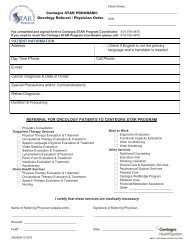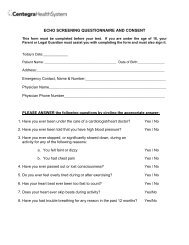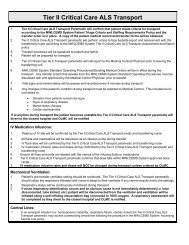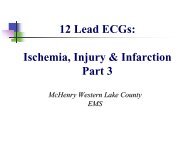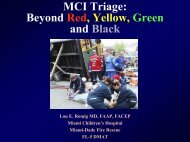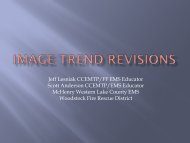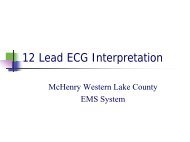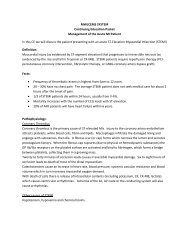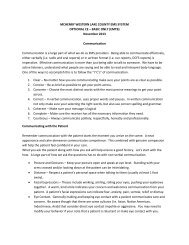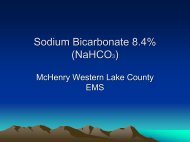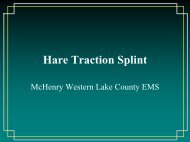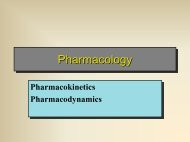Objectives
EMD Roles and Responsibilities Training Lesson - Centegra Health ...
EMD Roles and Responsibilities Training Lesson - Centegra Health ...
Create successful ePaper yourself
Turn your PDF publications into a flip-book with our unique Google optimized e-Paper software.
EMD Roles and Responsibilities<strong>Objectives</strong>• List/Explain 5 Functions of the EMD• Know the attributes for a Successful Dispatcher• Know the General Roles and Responsibility of the EMD• List 3 phases of Dispatch Function• Describe the EMS SystemThe Roles and Responsibilities of an EMD are intertwined with good telecommunicatorskills and medical knowledge. While most people feel that all you have to do is answer aphone to be a telecommunicator, there are a variety of skills that need to be learned. Whilemost agencies have a well developed training program to emphasize the proper way ofanswering and handling most calls. Individual departments will have slightly differentprotocols for a variety of call types, but there is sure to be at least one in your career that justdid not or will not fit into one of the protocols. By applying good telecommunicator skillsand having some medical knowledge you will be able to handle the call in an appropriatemanner.As the role of EMD has been evolving, several misconceptions have been identified. Theseare:• Callers are too upset to provide accurate and useful responses to the EMDquestions.• Callers would not be able to provide the EMD with required informationthat is necessary to effectively dispatch emergency medical resources.• The medical expertise required for effective emergency medical dispatchis not important, therefore public safety officials should use non-EMDdispatchers to dispatch resources.• The EMD is too busy dispatching to worry about asking all thosequestions, to provide instructions or use their protocol cards.
• Medical advice (provided over the phone) cannot help patients and couldactually be dangerous.• Using the EMDPRS increases the amount of time and resources requiredto process a call.As with all myths these have been dispelled. Callers are not too upset to provide accurateresponses. Callers simply need to be lead into the proper questions to get good answers. Theprotocols are designed so that you can get the proper medical information you need toeffective dispatch. This fact alone will separate the EMD from other public safetydispatchers. As we look at the subject of being ‘too busy’ to worry about asking questions,providing instruction and/or using the protocols, we all must remember “That is your job”.The job of dispatching includes the ability to ask the proper questions. The protocols list thequestions for you, making your job a little easier. The protocols that are used inMcHenry/Western Lake County EMS system have been reviewed and approved by ourmedical director, Dr. Pacini. The amount of time required to process a call with the use ofprotocols has actually stayed the same or in some instances has decreased. This is due to theuniformity in questioning. As the EMD evolves we need to keep up and remember that wetruly are professionals.Now that we have discussed some of the misconceptions, we can take a look at yourresponsibilities. An EMD receives and processes calls for emergency medical services,determine the nature and severity, coordinates and dispatches resources, and give assistancevia the EMDPRS. The EMD relays pertinent information, attempts to ensure the safety ofpatients and bystanders, and coordinates other public safety and EMS services as required.By staying on the phone and talking with the patient, and/or caller, the dispatcher can makethe difference between and controlled scene or complete panic.Being successful at your job is not just luck. Good dispatchers all seem to have the sameattributes and/or behaviors and some are learned skills. These would include:• Helpful and compassionate.The dispatcher tends to be the person who truly wants to help another• Ability to handle stressful situationsThe dispatcher needs to calm the caller and themselves in order to gather theinformation necessary for dispatch.
• Mastering the skills of EMDDispatching skills are learned with courses and practice. No dispatcher will walk outof class fully skilled in EMD. With a little extra practice and repeated reading of theinstructions, the skill level will improve.• Effectively gather informationA dispatcher will gather several pieces of information regarding an incident. Someinformation comes from the questions asked and other information will come fromvolunteered information given by the caller or noises heard in the background. Thedispatcher then processes this information, prioritizing and consolidates it into auseful format.• Assist responders in locating patients• Determines nature of medical situation without diagnosing• Reacts passively to hostile callers• Maintains confidentialityNow that you know what attributes make a good dispatcher, you need to remember that there arethree phases of the dispatch function. The first phase is receiving the call. During this phase thedispatcher:• Takes the incoming call• Engages caller in the initial survey• Then goes to the proper protocol for more information.Answering the call should always be done with the same line, 911 what is your emergency.From there the dispatcher will need to get the answers to “Where, what, how, who, when”.These questions are located under the Initial Survey tab in the protocols. Keep in mind whilegetting the information that the enhanced 911 information that comes in with the call shouldalways be verified. As soon as the information has been collected the dispatcher will then turn tothe appropriate instruction tab. Under the tab will be additional key questions at the top of thepage.The second phase, dispatch phase, will include:• Making sure you are on the correct tab• Protocols give appropriate response mode• Dispatches response personnel in proper configuration
This second phase includes making sure you are on the correct tab. Under the key questions youmay be directed to an alternative tab due to the answers to some questions. An example of thiswould be under the “Drug Overdose” tab. If the answer to key question 3 or 4 is yes, then youare directed to the appropriate tab. The dispatch decisions section II, will give you informationon priority and response order. Section II portion of the protocols are not used locally. The firedepartments in this area will make the decision on lights and sirens response as dictated by theirlocal departments. The response order is also not used locally. If an ambulance is requestedthen an ambulance gets dispatched. If there are response plans in the computer aided dispatchprogram then you will get a recommendation for units to be dispatched. Keep in mind that it isonly a recommendation and the individual department commander can request a change. Eachpolice department has their own policies on what type if any type of call the police will respondto. Some police agencies respond to every call when possible and others will only respond ifrequested by EMS or specific complaint types. Please review these policies for the policeagencies you dispatch for.The third phase of the dispatch function is the post-dispatch activities. This is done after theappropriate units are dispatched. In this phase the dispatcher will prepare the caller for thearrival of EMS personnel. This is when locking up of pets and unlocking the door or turning ona porch light at night, might be mentioned. It is at this point that the EMD should be givinginstructions to the caller, as specified in the protocols.Remember that if you have additional EMD’s with you that some of the responsibilities maybeshared. The dispatcher who answers the original call should stay with the caller in thosesituations, to prevent the re-asking of questions.We have discussed the different roles and responsibilities of the EMD. As we have looked at thedifferent responsibilities we can start to see how we fit into the EMS system as a whole. Thesystem we belong to is McHenry/Western Lake County EMS. The EMS systems are defined asa coordinated arrangement of resources, including personnel, equipment and facilities, organizedto respond to medical emergencies regardless of the cause. Telecommunicators are the firstpoint of contact for someone having such an emergency. Having received specified training toprepare for Emergency Medical Dispatching, you have become a vital part of the EMS system.
Name_______________________________Date___________________Roles and Responsibilities Evaluation Tool1. Name 3 misconceptions about EMD’s:• __________________________________________________________________• __________________________________________________________________• __________________________________________________________________2. The EMD uses __________________________ to provide pre-arrival instructions tocallers that prepare them for the responder’s arrival.3. List 5 attributes that makes for a good EMD:• __________________________________________________________________• __________________________________________________________________• __________________________________________________________________• __________________________________________________________________• __________________________________________________________________
Name_______________________________Date___________________4. What are the three phases of the dispatch function:• __________________________________________________________________• __________________________________________________________________• __________________________________________________________________5. List the 5 questions the EMD tries to answer using the interrogation procedures:• __________________________________________________________________• __________________________________________________________________• __________________________________________________________________• __________________________________________________________________• __________________________________________________________________



